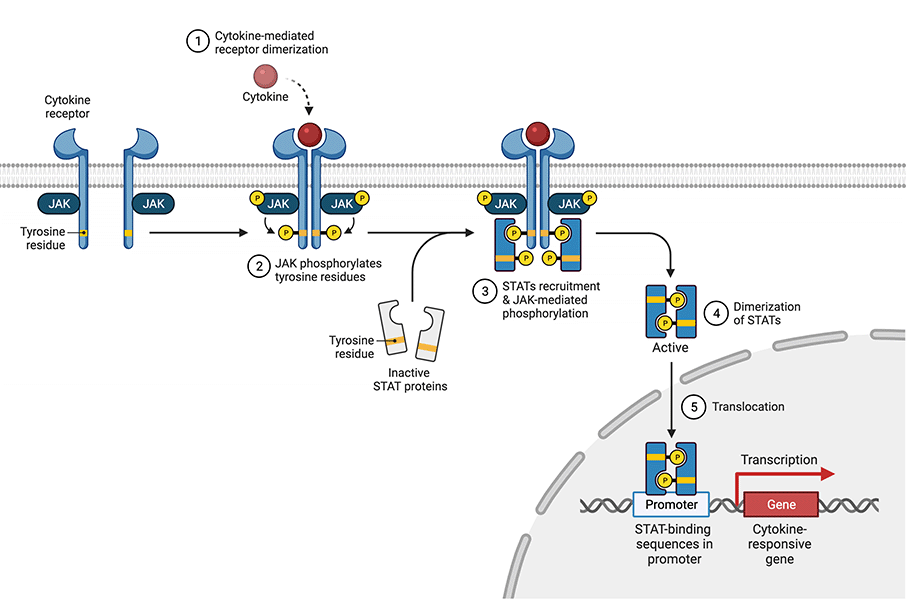STAT Signaling Antibodies
The STAT signaling system functions as a major signaling alternative to the second messenger system, consisting of a receptor and a Signal Transducer and Activator of Transcription (STAT). The STAT signaling pathway transmits information from chemical signals outside the cell into gene promoters on the DNA in the cell nucleus, causing DNA transcription and activity in the cell. The receptor is activated by a signal from interferons, interleukins, growth factors, or other chemical messengers that induce phosphorylation of the receptor. STAT proteins bind to the phosphorylated receptor, their phosphorylation is induced, and oligomerizes to other STAT proteins or further interaction proteins to then translocate into the cell nucleus. This oligomer forms a transcription factor that binds to DNA and promotes transcription of genes responsive to STAT.
There are 7 mammalian signal transducer and activator of transcription (STAT) family members which have been identified: STAT1, STAT2, STAT3, STAT4, STAT5 (STAT5A and STAT5B), and STAT6. STAT3, also known as Acute-Phase Response Factor (APRF), is a human transcription factor encoded by the STAT3 gene and mediates the cellular responses to interleukins, KITLG/SCF, and other growth factors. Without stimuli, it is predominantly present in the cytoplasm. STAT3 may mediate cellular responses through activation by FGFR1, FGFR2, FGFR3, FGFR4, EGF, BMX, IL11, LIF, CNTF, KITLG/SCF, CSF1, EGF, PDGF, IFN-alpha, OSM, and IL31 through IL31RA. Activated through tyrosine phosphorylation, STAT3 binds to the interleukin-6 (IL-6)-responsive elements identified in the promoters of various acute-phase protein genes.
DNA binding is facilitated by the formation of a homodimer or a heterodimer with a related family member (e.g. STAT1). STAT3 is critical to numerous cellular processes, including cell growth and apoptosis. Loss-of-function mutations in the STAT3 gene can result in recurrent infections as well as disordered bone and tooth development. Constitutive STAT3 activation is associated with various human cancers and has anti-apoptotic as well as proliferative effects. In a recent report on brain cancer, a connection was made between STAT3 and tumor suppression. Continued research into the mechanisms that interact on the cellular level will yield answers about cancer proliferation.
JAK/STAT Signaling Pathway
Cytokines and growth factors are the major activators of evolutionarily-conserved Janus kinase/signal transducers and activators of transcription (JAK/STAT) signaling pathway. Conserved in eukaryotic organisms from slime molds to humans, STAT signaling seems to be an early adaptation to facilitate intercellular communication co-evolved with a myriad of cellular signaling events, giving rise to highly adapted, ligand-specific signaling pathways that control gene expression.
The JAK/STAT signaling pathway transduces signals of more than 50 cytokines and peptide hormones adding plasticity to the response of a cell or tissue. The JAK/STAT pathway influences proliferation, differentiation, migration, apoptosis, and cell survival depending on the signal, tissue, and cellular context. JAK/STAT signaling is critical for numerous developmental and homeostatic processes, including hematopoiesis, immune cell development, stem cell maintenance, organismal growth, and mammary gland development.
The binding of a ligand to its respective receptor induces autoactivation of the receptor-associated JAK through trans-phosphorylation of tyrosine residues. Active JAKs subsequently phosphorylate critical tyrosines on the cytoplasmic portion of the receptor. These sites serve as docking sites for the SH2-domains of STATs, which get activated through phosphorylation by JAKs upon binding to this site of the receptor. Depending on the cell type and ligand-receptor complex, each JAK activates one or more of the members of the STAT family. Activated STATs separate from the receptor and form stable homo- or heterodimers and translocate to the nucleus where they function as transcription factors by binding to conserved DNA recognition sites.

Biological Reactions
In mammals, there are four members of the JAK family and seven STATs. Different JAKs and STATs are recruited based on their tissue specificity and the receptors engaged in the signaling event. Some of the JAK/STAT pathway components regulate, or are regulated, by members of other signaling pathways, including those involving the ERK MAP kinase, PI 3-kinase (PI3K), and others. Furthermore, non-canonical JAK and STAT activities influence the global transcriptional state through modification of chromatin structure. Disrupted or deregulated STAT functionality can result in some immune deficiency syndromes and cancers.
With over 20 years of experience in the development and validation of multiple assay formats, Rockland has shown a long line of success in delivering customer solutions and possesses the expertise in optimizing every aspect of an immunoassay specific to STAT proteins.
STAT Antibodies
| Product | Clonality | Reactivity | Application |
| Stat1 Antibody | Polyclonal | Mouse, Rat | WB, ELISA |
| STAT1 alpha Antibody | Polyclonal | Human, Mouse, Rat | WB, IHC, IF, IP, ELISA |
| STAT1 R31-Me2a Antibody | Polyclonal | Human | Dot Blot |
| Stat1 phospho Y701 Antibody | Polyclonal | Human | WB, ELISA |
| Stat2 Antibody | Monoclonal | Human | WB, IHC, ELISA |
| STAT2 phospho S734 Antibody | Polyclonal | Human, Monkey | WB, ELISA |
| STAT2 phospho Y690 Antibody | Polyclonal | Human, Mouse | WB, IHC, ELISA |
| STAT3 (Internal) Antibody | Polyclonal | Human | Dot Blot |
| STAT3 R31-Me2a Antibody | Polyclonal | Human | Dot Blot |
| STAT3 phospho Y705 Antibody | Polyclonal | Human | WB, IHC, ELISA |
| Stat4 Antibody | Polyclonal | Mouse | WB, IP, ELISA |
| Stat5 Antibody | Polyclonal | Human | WB, ELISA |
| Stat5 phospho Y694 Antibody | Monoclonal | Human, Mouse | |
| STAT5 R31-Me1 Antibody | Polyclonal | Human | Dot Blot |
| Stat5 phospho Y694 Antibody | Monoclonal | Human, Mouse | WB, IHC, IF, ELISA |
| Stat5 phospho Y694 Antibody | Polyclonal | Human | WB, IHC, ELISA |
| STAT6 phospho Y641 Antibody | Polyclonal | Human | WB, IHC, ELISA |